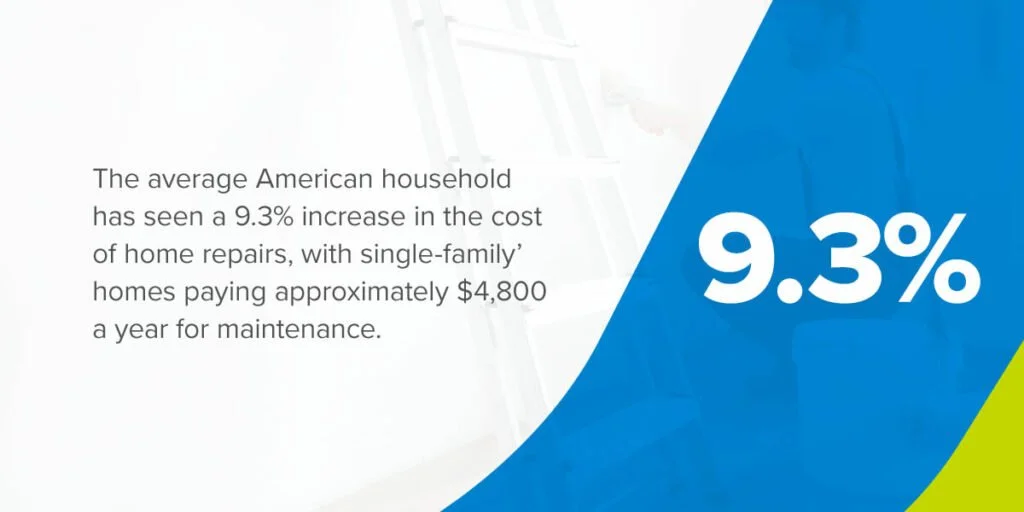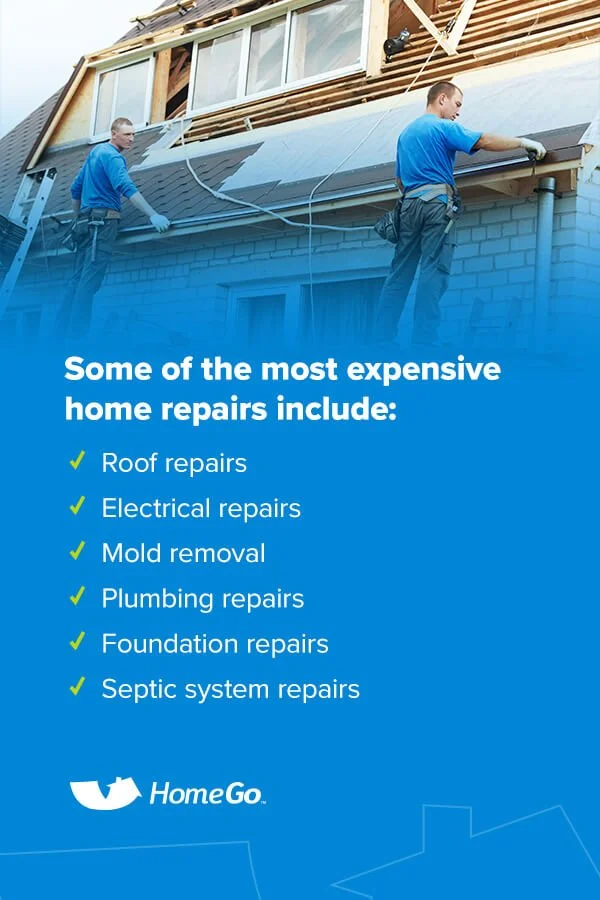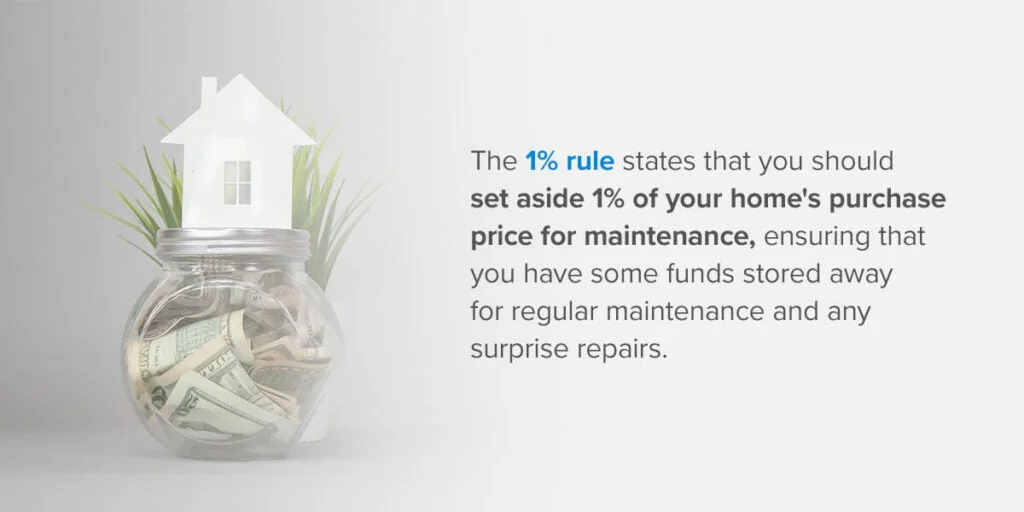Many homeowners are unaware of how expensive maintenance costs can be, but they’re a necessary part of owning a home. If you plan to sell your home on the market, it’s even more essential to practice regular maintenance on the various aspects of your home to ensure it maintains its value over time.
Homeowners must also account for repairs, especially with an older home, as things can break down unexpectedly. Learn more below about the average cost of home maintenance, how you can budget for common home repairs and costs and what you should regularly maintain in your home. You’ll also learn how to sell your house quickly without worrying about costly repairs.
What Is the Average Annual Home Maintenance Cost?
If you own a home, you’re likely familiar with needing to repair your home and conduct routine maintenance to keep it in tip-top shape. As a homeowner, you’ll have to handle the costs of home maintenance, utilities, insurance and property taxes. These costs can quickly add up, especially if you’re trying to repair your home before selling.

The average American household has seen a 9.3% increase in the cost of home repairs, with single-family homes paying approximately $4,800 a year for maintenance. Many of these costs are associated with labor and material costs. Some Americans are paying up to $10,000 yearly on repairs since more people are investing in their homes and property.
While some of these repairs or maintenance projects can upgrade the home, many are often necessary to ensure the home runs correctly. For example, the HVAC unit may give out after years of use, or you may be conducting regular maintenance to keep it operational.
The HVAC system is just one of many parts of your home that will need regular maintenance, especially in older homes. You will need to budget for costly annual maintenance. The amount you budget will depend on the cost of your home and other various factors.
Factors Affecting the Average Cost of Maintenance
When you’re looking to start saving for your annual home maintenance and repairs, you’ll need to consider your home’s price, age, condition and location. Each of these factors can affect the cost of maintenance in different ways:
- Price: If your home has a higher market value, it’s likely because you have more space, amenities or upgraded appliances than other homes. For example, a home with an in-ground pool can increase the value of a home by between 5% and 8%. Having a pool also means you’ll need to save up more for regular maintenance to keep it in tip-top condition. The higher the price of your home and the more you need to take care of it, the more you’ll need to budget for your maintenance costs.
- Age and condition: Older homes cost more to maintain since the building materials and amenities wear down, even if they’re kept in good condition. Older technology also tends to give out sooner than new and improved tech, so you may need to replace older appliances more frequently. However, older homes are generally less expensive for this reason, meaning it could be easier to save up for the most common home repairs.
- Location: Location plays a significant role in the cost of maintenance. The cost of living is rising in many places, especially big cities, so homeowners who live in these areas should expect to pay more for annual maintenance. You’ll also need to account for the cost of materials and labor in your location, especially for maintenance projects that require professional help. Any labor shortages should also be factored into your expenses.
When looking for sources regarding the expected cost for your annual maintenance, look at a range of numbers to get an accurate estimate of what you need to be saving each year. Use average numbers as baselines and create your own unique budget, accounting for different factors.
Common Maintenance Costs for Your House Every Year or Two
Annual or biannual maintenance is essential to ensure that your home operates correctly and you won’t have to shell out for expensive repairs or replacements in the future. Many common essential commodities and cosmetic amenities require consistent maintenance to keep the value of your home as high as possible.
Some of the most common average maintenance costs for your home include:
- $105 for pool cleaning.
- $19 for lawn maintenance.
- $116 to power wash the house.
- $600 to replace the water filtration system.
- $1,786 to replace the pool filtration system.
- $27 to aerate the lawn.
- $111 to check for plumbing leaks.
There are more maintenance costs you’ll need to consider, depending on the amenities in your home. For example, you may have an expensive HVAC system that requires annual maintenance. The frequency of maintenance will depend on each project. For example, a pool should be deep cleaned once every two months or so, but you only need to powerwash a fence every two or three years.
Regularly maintaining different things in your home is essential to ensure that every system and amenity remains in peak condition, sustaining your home’s value. Regular maintenance will also make your home easier to sell, especially if you’re trying to get out of it quickly.
Common Major Home Repairs
Maintenance can help keep your home at its best, but things sometimes break or run down, meaning you’ll have to pay for repairs or replacements. Certain items or amenities in the home are more likely to need repairs than others. Some of the most common major home repairs include:
- Heating and air conditioning
- Roof shingles or tiles
- Furnace and heating oil system
- Washer and dryer
- Plumbing
- Electrical
- Flooring or carpet replacements
- Landscaping and driveway
- Water heater
- Interior and exterior paint

Most people won’t have to pay for these repairs all at once if they conduct regular maintenance. However, if you own a home that’s behind its regular maintenance schedule, you may end up paying for costly repairs. Some of the most expensive home repairs include:
- Roof repairs: Failing to perform maintenance on your roof can lead to extensive roof repairs. Other times, natural causes can require a roof repair, such as a tree falling on your home during a storm. A heavily damaged roof can cost up to $12,000 to replace, and that’s without accounting for the cost of your old roof removal.
- Electrical repairs: Electrical problems can be dangerous for individuals in your home, putting you at risk for fires or electrocution. Both events can also damage your home, so it’s essential not to put off these repairs for a later date. If you need to repair the electrical system in your home, it’s always a good idea to hire a professional who understands the necessary safety measures. Electrical repairs can vary based on the severity of the problem but can range from $300 to $4000.
- Mold removal: When you have mold damage, it can be dangerous to your health and the structural integrity of your home to put off repairs. While you can treat minor mold growth yourself, it’s always a good idea to have a professional check your home for additional mold outbreaks and treat them with professional-grade chemicals to protect your health. Mold removal can cost anywhere between $500 to $6,000, depending on the extent of your damage.
- Plumbing repairs: Plumbing repairs can be a high cost for many homeowners, especially if the damage is extensive or if they live in an older house. If you leave plumbing problems untreated, you may experience water damage, resulting in the need for even further repairs. While minor issues could be repaired on your own, a professional plumber should handle the majority of plumbing issues. Depending on the extent of the damage, you can expect to pay between $100 to $10,000 for repairs.
- Foundation repairs: Your foundation is an essential part of your home that keeps the rest intact. While you can sell a house with foundation damage, waiting to repair your foundation can cause further problems, such as cracks in the walls, water damage and misaligned door frames. If you need to fix your foundation, you could pay between $10,000 to $40,000 for severe damage.
- Septic system repairs: When your septic system breaks, it can be highly inconvenient and messy. Septic system repairs also require professional help to ensure that your system will adequately work once everything is said and done. While individual prices may seem low, you could end up paying up to $12,000 once everything comes together.
Repairing these systems or amenities can break the bank for some homeowners, especially if they haven’t saved for costly repairs or more than one thing needs repairing simultaneously. These repairs can burden individuals trying to sell their homes and move as soon as possible. Waiting to save enough to complete repairs is sometimes not an option for homeowners who are moving for a new job or another immediate reason.
Luckily, there are options for homeowners who want to sell their home as quickly as possible, even if it needs repairs. We’ll discuss these options later in this article.
Planning a Budget for Home Maintenance
Rather than waiting for things to break and shelling out for costly repairs, you can plan a budget and start saving for regular maintenance, preventing the need for repairs in the first place. If you’ve never budgeted for repairs before, you may not know where to start.

If you’re just starting out, you can follow the 1% rule. This rule states that you should set aside 1% of your home’s purchase price for maintenance, ensuring that you have some funds stored away for regular maintenance and any surprise repairs. For example, if your home is worth $300,000, you should set aside $3,000 for annual maintenance costs.
However, the 1% rule doesn’t always work for everyone. Other factors can affect the cost of regular maintenance, such as the age of your home and its current condition. If your property is older, you’ll likely need to set aside additional funds to repair outdated systems.
If the 1% rule doesn’t work for your home, you can calculate home maintenance costs using the square-footage rule. Using this rule, you’d put away $1.00 for each square foot of your home. If you live in a home that’s 2,000 square feet, you would need to save $2,000 for annual maintenance costs.
Again, this rule won’t work for every instance. Some homes are older and will require more in-depth maintenance and extensive repairs. Using this rule, it would also be harder to account for labor and materials costs. Still, both the 1% and square-footage rule are good starting points for homeowners who have never budgeted for maintenance or repair costs before.
If your home meets specific conditions, then you should be saving more. For example, you might try saving 3% of your home’s purchase price rather than 1%. Consider saving more if your home is:
- Built with low-quality materials or those with a short life span.
- Over 10 years old.
- In a wet or stormy environment.
You can also adequately prepare for maintenance costs by keeping a careful eye on the condition of your home. Routine inspections can help you determine if something needs a bit of upkeep or a replacement. For example, you can check your faucets regularly for leaks to ensure you don’t need any plumbing repairs, fixing minor issues before they become more significant.
You can also check in on the quality of your roof, looking for any broken tiles or missing shingles. Regularly replacing your HVAC filter can also prevent you from having to replace the unit entirely.
Planning a budget for maintenance will help prevent the need for expensive repairs. However, sometimes things break down unexpectedly, and you’ll need to pay for repairs. Accommodating for the unexpected can help keep you out of a tight spot.
Costly Repairs Before Selling? Get an Offer to Sell As-Is
If you’ve been trying to sell your home, shelling out the funds for repairs can be time-consuming, tedious and a waste of money. If the repairs are extensive, you may spend more than your home is worth without seeing a return on investment. Instead, you can choose to sell your house as-is without having to put any money into repairs, upgrades or renovations.
HomeGo is a home buying company that will take the burden of presale repairs off your shoulders. We’ll conduct a short walkthrough of your home and assess the value of your property against the current market value. In most cases, we can make you can offer the same day. Once you accept, we’ll help you through the entire process, and you can close in as little as seven days.
If you’re not ready to move out within seven days, we offer a leaseback program so you can stay in your home while you prepare for your move. You’ll have extra time to pack, close the deal on your new home and make travel and moving arrangements.
You don’t have to worry about the condition of your home when you sell to us. Once you close the deal, we’ll handle all the repairs and factor in the cost of these renovations during our assessment and offer. With HomeGo, you can get out from underneath a home that requires costly repairs, allowing you to save money and move to the home of your dreams. Schedule a walkthrough to get started, or contact us today to learn more.





